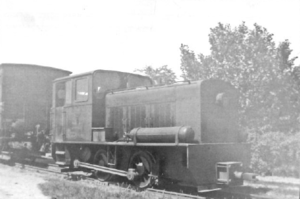Wandsbeker Industriebahn V 6
| Wandsbeker Industriebahn 6 | |
|---|---|
|
historical recording
|
|
| Numbering: | Wandsbeker Industriebahn 6 |
| Number: | 1 |
| Manufacturer: |
KHD serial number 36778 |
| Year of construction (s): | 1941 |
| Retirement: | 1966 |
| Axis formula : | B. |
| Gauge : | 1000 mm ( meter gauge ) |
| Length over buffers: | 6,450 mm |
| Height: | 3,000 mm |
| Width: | 2,380 mm |
| Total wheelbase: | 1,600 mm |
| Service mass: | 20 t |
| Friction mass: | 20 t |
| Wheel set mass : | 10 t |
| Top speed: | 25 km / h |
| Installed capacity: | originally 121.5 kW (165 PS) after conversion 147 kW (200 PS) |
| Starting tractive effort: | 70 kN |
| Driving wheel diameter: | 850 mm |
| Motor type: | Originally KHD A6M 420 after conversion MAN W6 V17.5 / 22 |
| Motor type: | 6-cylinder four-stroke diesel engine with supercharging |
| Rated speed: | 1,000 / min |
| Power transmission: | mechanically |
| Tank capacity: | 225 l |
| Brake: | Handbrake oil pressure brake |
The Wandsbeker Industriebahn 6 narrow-gauge diesel locomotive belongs to the KHD A6M 420 R series from KHD . It is the only known machine of this type series that was manufactured for the meter gauge.
The locomotive was used for shunting with trolleys on the industrial railway until it ceased operations in 1966. In 1967 it was scrapped.
history
In order to distribute the freight cars delivered by the Lübeck-Büchener Eisenbahn in the Hamburg-Wandsbek area , the Wandsbeker Industriebahn procured this diesel locomotive in 1941 . It was derived from the KHD A6M 420 R type B series for the meter gauge.
After the Second World War it was equipped with a more powerful engine. In 1957 she had a break in the jackshaft . After the Wandsbeker Industriebahn 2 and 3 locomotives were delivered , it remained in service. After the Wandsbeker industrial railway was closed in 1966, it was shut down and scrapped in 1967.
technology
The locomotive had a machine front and a driver's cab behind it. The power was transmitted by means of a rod drive , with the jackshaft as the transmission output shaft, unlike the standard gauge variant , being mounted behind the drive wheels under the driver's cab. A drive rod drove the front axle of the locomotive, both axles were connected with coupling rods.
The locomotives had a high-speed six-cylinder four-stroke diesel engine from KHD, which was followed by a single- disk dry clutch with an oil-pressure-operated change gearbox with reversing gear. After the Second World War, the engine was swapped for one from MAN that was started with compressed air.
She had a spacious cab with large windows. It had an oil pressure brake to brake all locomotive wheels by means of brake pads and a parking brake.
literature
- Dirk Oetzmann: The Hamburg narrow-gauge railways . Association of traffic amateurs and museum railways V., Hamburg 2010, ISBN 978-3-923999-77-4 , pp. 85-87 .
Web links
- Website about Deutz locomotives before 1954 at www.lokmacher.de
- Database acquisition of the KHD A6M 420R locomotive of the Wandsbeker industrial railway
Individual evidence
- ↑ Database recording of the KHD A6M 420R locomotive
- ↑ Dirk Oetzmann: The Hamburg narrow-gauge railways . Association of Traffic Amateurs and Museum Railways eV, Hamburg 2010, ISBN 978-3-923999-77-4 , p. 91 .
